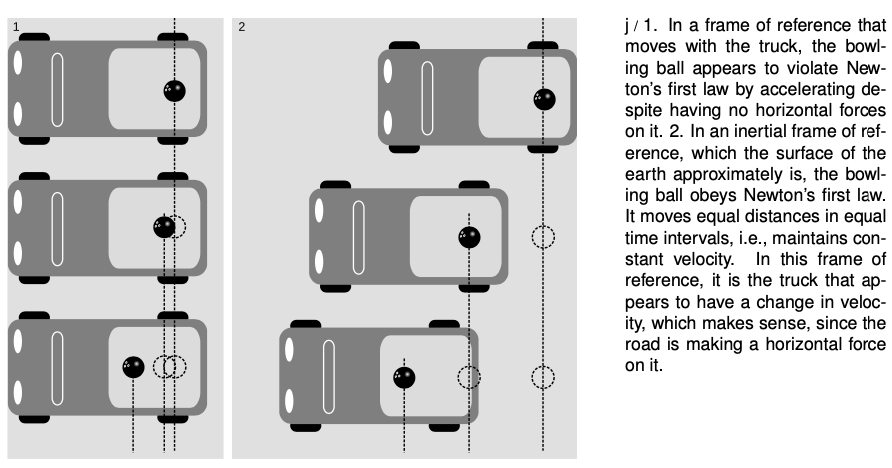LM 4_5 Inertial and noninertial frames of reference Collection
4.5 Inertial and noninertial frames of reference by Benjamin Crowell, Light and Matter licensed under the Creative Commons Attribution-ShareAlike license.
4.5 Inertial and noninertial frames of reference
One day, you're driving down the street in your pickup truck, on your way to deliver a bowling ball. The ball is in the back of the truck, enjoying its little jaunt and taking in the fresh air and sunshine. Then you have to slow down because a stop sign is coming up. As you brake, you glance in your rearview mirror, and see your trusty companion accelerating toward you. Did some mysterious force push it forward? No, it only seems that way because you and the car are slowing down. The ball is faithfully obeying Newton's first law, and as it continues at constant velocity it gets ahead relative to the slowing truck. No forces are acting on it (other than the same canceling-out vertical forces that were always acting on it).3 The ball only appeared to violate Newton's first law because there was something wrong with your frame of reference, which was based on the truck.

How, then, are we to tell in which frames of reference Newton's laws are valid? It's no good to say that we should avoid moving frames of reference, because there is no such thing as absolute rest or absolute motion. All frames can be considered as being either at rest or in motion. According to an observer in India, the strip mall that constituted the frame of reference in panel (b) of the figure was moving along with the earth's rotation at hundreds of miles per hour.
The reason why Newton's laws fail in the truck's frame of reference is not because the truck is moving but because it is accelerating. (Recall that physicists use the word to refer either to speeding up or slowing down.) Newton's laws were working just fine in the moving truck's frame of reference as long as the truck was moving at constant velocity. It was only when its speed changed that there was a problem. How, then, are we to tell which frames are accelerating and which are not? What if you claim that your truck is not accelerating, and the sidewalk, the asphalt, and the Burger King are accelerating? The way to settle such a dispute is to examine the motion of some object, such as the bowling ball, which we know has zero total force on it. Any frame of reference in which the ball appears to obey Newton's first law is then a valid frame of reference, and to an observer in that frame, Mr. Newton assures us that all the other objects in the universe will obey his laws of motion, not just the ball.
Valid frames of reference, in which Newton's laws are obeyed, are called inertial frames of reference. Frames of reference that are not inertial are called noninertial frames. In those frames, objects violate the principle of inertia and Newton's first law. While the truck was moving at constant velocity, both it and the sidewalk were valid inertial frames. The truck became an invalid frame of reference when it began changing its velocity.
You usually assume the ground under your feet is a perfectly inertial frame of reference, and we made that assumption above. It isn't perfectly inertial, however. Its motion through space is quite complicated, being composed of a part due to the earth's daily rotation around its own axis, the monthly wobble of the planet caused by the moon's gravity, and the rotation of the earth around the sun. Since the accelerations involved are numerically small, the earth is approximately a valid inertial frame.
Noninertial frames are avoided whenever possible, and we will seldom, if ever, have occasion to use them in this course. Sometimes, however, a noninertial frame can be convenient. Naval gunners, for instance, get all their data from radars, human eyeballs, and other detection systems that are moving along with the earth's surface. Since their guns have ranges of many miles, the small discrepancies between their shells' actual accelerations and the accelerations predicted by Newton's second law can have effects that accumulate and become significant. In order to kill the people they want to kill, they have to add small corrections onto the equation a=Ftotal/m. Doing their calculations in an inertial frame would allow them to use the usual form of Newton's second law, but they would have to convert all their data into a different frame of reference, which would require cumbersome calculations.
Discussion Question
A If an object has a linear x−t graph in a certain inertial frame, what is the effect on the graph if we change to a coordinate system with a different origin? What is the effect if we keep the same origin but reverse the positive direction of the x axis? How about an inertial frame moving alongside the object? What if we describe the object's motion in a noninertial frame?
4.5 Inertial and noninertial frames of reference by Benjamin Crowell, Light and Matter licensed under the Creative Commons Attribution-ShareAlike license.
Equations
- Acceleration from Force and Mass KurtHeckman Use Equation
- Comments
- Attachments
- Stats
No comments |
